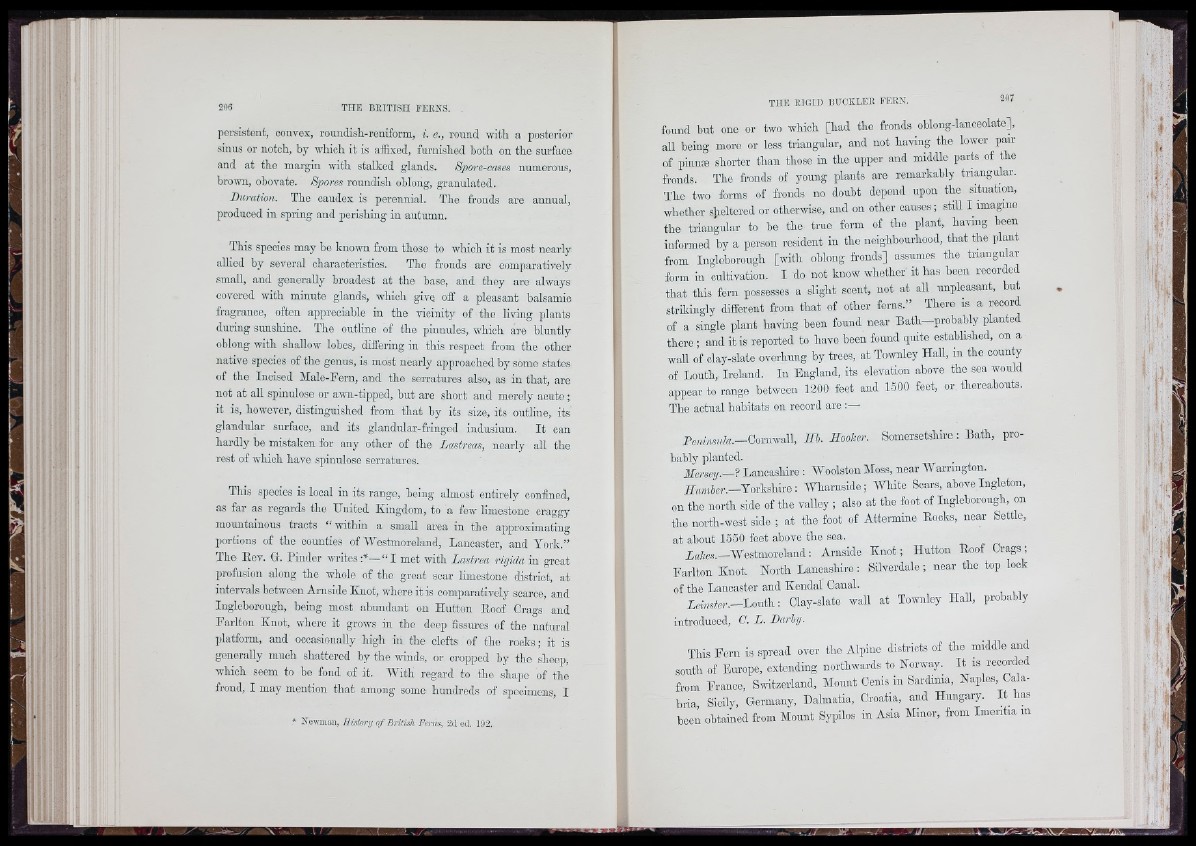
persistent, convex, roundisli-reniform, i. e., round with, a posterior
sinus or notch, hy Avhich it is affixed, furnishod both on the sui’faoe
and at the margin Avith stalked glands. Spore-cases numerous,
broAvn, obovate. Spores roundish oblong, granulated.
Duration. The caudex is perennial. The fronds are annual,
produced in spring and perishing in autumn.
This species may be knoAAm from thoso to Avhich it is most nearly
allied by several oharaotoristics. Tho fronds are comparatively
small, and gonorally broadest at tho base, and they are ahvays
ooArerod Avith minute glands, which give off a pleasant balsamic
fragrance, often appreciable in the vicinity of the living plants
during sunshine. Tho outlino of the pinnules, which are bluntly
oblong with shalloAv lobes, differing in this respect from the other
native species of the genus, is most noarly approached by some states
of the Incised Male-Fern, and the serratures also, as in that, are
not at all spinulose or aAA'n-tipped, hut are short and merely acute;
it is, however, distinguished from that hy its size, its outline, its
glandular surface, and its glandular-fringed indusium. I t can
hardly he mistaken for any other of tho Lastreas, noarly all the
rest of Avhioh harre spinulose serratures.
This species is local in its range, being almost entirely confined,
as far as regards the United Kingdom, to a few limestone craggy
mountainous tracts “ AAilíhin a small area in tbo approximating
portions of the counties of JVestmoreland, Lancaster, and York.”
The- Rev. G. Pinder AAuitos “ I mot Avith Lastrea rigida in groat
profusion along tho Avholo of tho groat soar limostono district, at
interA'als betAvoon Arnsido Knot, where it is comparatively scarce, and
Ingleborough, being most abundant on Hutton Roof Crags and
Farlton Knot, Avbero it groAvs in tho deep fissures of the natural
platform, and occasionally high in the olofts of tho rocks; it is
generally much shattered by tho Avinds, or cropped hy tho sheop,
Avhioh seem to be fond of it. JVith regard to tho shape of the
frond, I may mention that among some hundreds of specimens, I
« NeAvinan, Ilistartj o f British Ferns, 2il ed. 192.
found hut one or two Avhioh [had the fronds ohlong-laneeolate],
all being moro or less triangular, and not having tho loAver pair
of pinnæ shorter than those in the upper and middle parts of the
fronds. The fronds of young plants are remarkably triangular.
Tho two forms of fronds no doubt depend upon tho situation,
Avhethor sheltered or othei’Avise, and on other causes ; still I imagine
the triangular to he tho true form of the plant, haA-ing been
informed hy a person resident in the neighbourhood, that the plant
from Ingleborough [with oblong fronds] assumes the triangular
form in cultivation. I do not know Avhcthor it has boon recorded
th a t this fern possesses a slight scent, not at all unpleasant, but
strikingly different from that of other ferns.” There is a record
of a single plant having been found near R a th -p ro h ab ly planted
there ; and it is reported to have been found quite established, on a
wall of olay-slate overhung hy trees, at ToAvnley Hall, in the county
of Louth, Ireland. In England, its elevation above tho sea would
appear to range between 1200 feet and 1500 feet, or thereabouts.
The actual habitats on record arc :
P e n in s u la .— ConvFaW, Hb. Hooker. Somersetshire : Rath, probably
planted.
Mersey.— ? Lancashire : Woolston Moss, near Warrington.
H u m b e r . -Y o A û r im - . Yffiarnside; White Scars, above Ingleton,
on the north side of the valley ; also at the foot of Ingleborough, on
the north-west side ; at the foot of Attermine Rooks, near Settle,
at about 1550 feet above the sea.
Lakes.—aYestmoroland : Arnsido Knot ; Hutton Roof Crags ;
Farlton Knot. North Lancashire : Silverdale ; near the top look
of the Lancaster and Kendal Canal.
L e in s t e r . -L o x A k - . Clay-slate wall at ToAvnloy Hall, probably
introduced, C. L. Darby.
This Fern is spread over tho Alpine districts of the middle and
south of Europe, extending northwards to Norway. I t is recorded
from France, Sivitzerland, (Mount Cenis in Sardinia, Naples, Calabria
Sicily, Germany, Dalmatia, Croatia, and Hungary. I t has
boon obtained from Mount Sypilos in Asia Minor, from Imeritia in
.”1*
I.'-' J
f ■ if